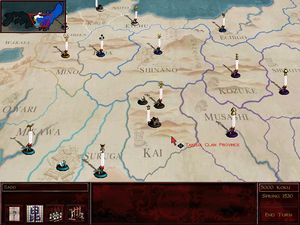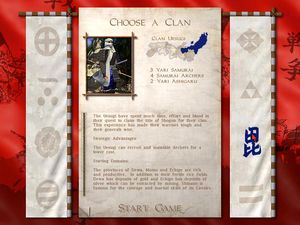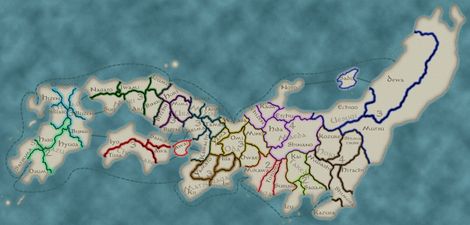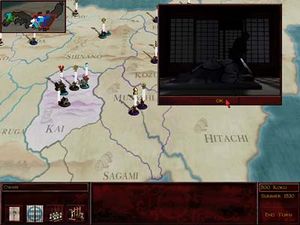Difference between revisions of "Shogun: Total War"
(not perfect but I think it's cleaned up as much as it can hope for right now, + some relevant external links) |
|||
| (42 intermediate revisions by 19 users not shown) | |||
| Line 1: | Line 1: | ||
| − | + | {{Total War}} | |
| + | '''Shogun: Total War''' was the first game in the Total War series and was released by Electronic Arts in June of 2000. | ||
| − | Shogun: Total War | + | Shogun: Total War, also known as STW, is a history-based strategy game that combines turn-based provincial development with real-time battles. The player assumes the role of one of seven daimyos (Uesugi, Shimazu, Oda, Mori, Imagawa, Takeda, Hōjō) attempting to unite feudal Japan during the Sengoku period ("The Age of the Country at War") and become Shogun. Sun Tzu's The Art of War is central to the game; its precepts are quoted often and its strategies are recommended. |
| + | |||
| + | |||
| + | == Features == | ||
| + | |||
| + | === Gameplay === | ||
| + | [[File:Shogun Total War map2.jpg|thumb|right|Much of the game takes place on a turn-based strategy map of Japan]] | ||
| + | The play involves a strategic phase building up armies and moving them into provinces followed by a real time battle phase. During the strategic phase the players can decide where they are going to move their forces. Afterwards, once the player has issued his commands, the ordered movements are executed simultaneously. The three-dimensional battles are notable for including new aspects such as morale which had usually been ignored by computer war games prior to STW. Many of these features are generally more typical of table top gaming. | ||
| + | Sieges are played out using the same engine as the battles in the field. The advantage to the defender comes from the narrow gateway to the castles which prevents a larger force from attacking with more than a small part of its strength. | ||
| + | |||
| + | === Historical Battles === | ||
| + | Some of feudal Japan's greatest battles were recreated based on the expertise of some of the period's leading historical authorities. | ||
| + | |||
| + | === Factions === | ||
| + | [[File:Shogun Total War Choose a clan.jpg|thumb|left|One of the possible faction choices]] | ||
| + | [[File:Shogun Total War Campaign map.jpg|470px|thumb|right|Campaign map with factions in colorcode]] | ||
| + | |||
| + | The 7 playable factions in Shogun, with their faction colour: | ||
| + | |||
| + | *[[Hōjō (STW Faction)|Hojo]] (Purple) | ||
| + | *[[Imagawa (STW Faction)|Imagawa]] (Light Blue) | ||
| + | *[[Mori (STW Faction)|Mori]] (Red) | ||
| + | *[[Oda (STW Faction)|Oda]] (Gold) | ||
| + | *[[Takeda (STW Faction)|Takeda]] (Black) | ||
| + | *[[Shimazu (STW Faction)|Shimazu]] (Green) | ||
| + | *[[Uesugi (STW Faction)|Uesugi]] (Dark Blue) | ||
| + | |||
| + | Each of these factions has an identical unit roster, but all receive a bonus (usually in the form of a discount) in training a particular unit.: For example, the Uesugi faction recruits Samurai Archers at a lower cost than the other factions. | ||
| + | |||
| + | The Mongol Invasion expansion added a new, unique faction, the Mongols. | ||
| + | |||
| + | === Religions === | ||
| + | |||
| + | *Buddhism- standard religion of the Japanese factions. | ||
| + | |||
| + | *Christianity- optional religion, which can be obtained by accepting the Portuguese deal. | ||
| + | |||
| + | === Units === | ||
| + | |||
| + | The unit roster in Shogun Total War is small in comparison to the later games, with all factions in the original game sharing the same unit roster. However each faction receives a discount on purchasing a particular unit, and furthermore some provinces grant an experience bonus to units of a particular type recruited there. | ||
| + | |||
| + | ====Japanese Factions==== | ||
| + | [[File:Shogun Total War unit no-dachi.jpg|470px|thumb|right|A unit of No-Dachi takes battle position]] | ||
| + | *Infantry Units: | ||
| + | **Yari Ashigaru (Light Spearmen) | ||
| + | **Yari Samurai (Heavy Spearmen) | ||
| + | **Samurai Archers | ||
| + | **No-Dachi Samurai (Offensive Infantry) | ||
| + | **Naginata Samurai (Defensive Infantry) | ||
| + | **Warrior Monks (Elite Infantry, not available to Christians) | ||
| + | **Arquebusiers (Basic firearm unit, unlocked through trade with Europeans) | ||
| + | **Musketeers (Superior late-game firearm unit) | ||
| + | : | ||
| + | *Cavalry Units: | ||
| + | **Yari Cavalry (Light Lancers) | ||
| + | **Cavalry Archers | ||
| + | **Heavy Cavalry (Heavy Melee Cavalry) | ||
| + | **Hatamoto (as Heavy Cavalry, bodyguard of a general and not recruitable) | ||
| + | :[[File:Shogun_Total_War_ingame_video.jpg|thumb|right|A video plays after a ninja has attempted a assassination.]] | ||
| + | *Agents (on the strategic map): | ||
| + | **Diplomat | ||
| + | **Shinobi (Spy) | ||
| + | **Ninja (Assassin) | ||
| + | **Jesuit Priest (Diplomat for Christian factions) | ||
| + | **Legendary Geisha (late-game Elite Assassin) | ||
| + | |||
| + | ====The Mongols==== | ||
| + | |||
| + | [[File:Shogun Total War unit mongols.jpg|470px|thumb|right|One of the possible new mongol units]] | ||
| + | The Mongol Invasion expansion added a new faction and with it a set of new units: | ||
| + | *Infantry Units: | ||
| + | **Korean Skirmishers (Light Infantry, javelins) | ||
| + | **Korean Spearmen (Heavy Spearmen) | ||
| + | **Korean Guardsmen (Heavy Infantry) | ||
| + | **Thunder Bombers ("Grenadier" infantry with bombs) | ||
| + | : | ||
| + | *Cavalry Units: | ||
| + | **Mongol Light Cavalry (Superior Cavalry Archers) | ||
| + | **Mongol Heavy Cavalry (Heavy Melee Cavalry) | ||
| + | : | ||
| + | Additionally, the Japanese factions gained several new units in the expansion: | ||
| + | *Japanese Units in MI: | ||
| + | **Naginata Cavalry (Medium Cavalry) | ||
| + | **Battlefield Ninjas (Elite stealth unit) | ||
| + | **Kensai (Elite Swordsman, extremely powerful 1-man unit) | ||
| + | **Ashigaru Crossbowmen (MI Campaign only, replaces gunpowder units) | ||
| + | |||
| + | == Expansions == | ||
| + | |||
| + | Shogun Total War had one expansion, [[Mongol Invasion]]. Its main addition was to add a new campaign set in 1230, hypothesizing a successful Mongol landing in Japan. This campaign had only 2 factions, the Hojo (possessing all of Japan) and the new faction, the Mongols. The gameplay of this campaign was notable in that the Mongols were unable to recruit troops in any conquered provinces, but instead had to rely on reinforcements periodically appearing in coastal provinces to replenish their troops. In addition to this campaign, the expansion also added "eras" to the original campaign, as well as several new units and Historical Battle Campaigns, Campaigns played through Historical Battles. | ||
| + | |||
| + | [[Creative Assembly]] also subsequently released Shogun Total War: Warlord Edition, a compilation package containing both the original game and the expansion, and featuring a new introductory movie. | ||
| + | |||
| + | ==External Links== | ||
| + | * [https://www.twcenter.net/forums/forumdisplay.php?2244-Shogun-Total-War Shogun Discussion on TWC] | ||
| + | * [https://forums.totalwar.org/vb/forumdisplay.php/14-Shogun-Total-War Shogun Forum at TotalWar.org] | ||
| + | * [https://store.steampowered.com/app/345240/SHOGUN_Total_War__Collection Shogun on Steam] | ||
| + | |||
| + | [[Category:Total War Series]] | ||
| + | [[Category:STW Information]] | ||
Latest revision as of 04:22, 19 October 2023
| Total War Series |
|---|
|
Total War: Three Kingdoms - Portal Total War Saga: Thrones of Britannia Medieval II: Total War - Portal |
Shogun: Total War was the first game in the Total War series and was released by Electronic Arts in June of 2000.
Shogun: Total War, also known as STW, is a history-based strategy game that combines turn-based provincial development with real-time battles. The player assumes the role of one of seven daimyos (Uesugi, Shimazu, Oda, Mori, Imagawa, Takeda, Hōjō) attempting to unite feudal Japan during the Sengoku period ("The Age of the Country at War") and become Shogun. Sun Tzu's The Art of War is central to the game; its precepts are quoted often and its strategies are recommended.
Contents
Features
Gameplay
The play involves a strategic phase building up armies and moving them into provinces followed by a real time battle phase. During the strategic phase the players can decide where they are going to move their forces. Afterwards, once the player has issued his commands, the ordered movements are executed simultaneously. The three-dimensional battles are notable for including new aspects such as morale which had usually been ignored by computer war games prior to STW. Many of these features are generally more typical of table top gaming. Sieges are played out using the same engine as the battles in the field. The advantage to the defender comes from the narrow gateway to the castles which prevents a larger force from attacking with more than a small part of its strength.
Historical Battles
Some of feudal Japan's greatest battles were recreated based on the expertise of some of the period's leading historical authorities.
Factions
The 7 playable factions in Shogun, with their faction colour:
- Hojo (Purple)
- Imagawa (Light Blue)
- Mori (Red)
- Oda (Gold)
- Takeda (Black)
- Shimazu (Green)
- Uesugi (Dark Blue)
Each of these factions has an identical unit roster, but all receive a bonus (usually in the form of a discount) in training a particular unit.: For example, the Uesugi faction recruits Samurai Archers at a lower cost than the other factions.
The Mongol Invasion expansion added a new, unique faction, the Mongols.
Religions
- Buddhism- standard religion of the Japanese factions.
- Christianity- optional religion, which can be obtained by accepting the Portuguese deal.
Units
The unit roster in Shogun Total War is small in comparison to the later games, with all factions in the original game sharing the same unit roster. However each faction receives a discount on purchasing a particular unit, and furthermore some provinces grant an experience bonus to units of a particular type recruited there.
Japanese Factions
- Infantry Units:
- Yari Ashigaru (Light Spearmen)
- Yari Samurai (Heavy Spearmen)
- Samurai Archers
- No-Dachi Samurai (Offensive Infantry)
- Naginata Samurai (Defensive Infantry)
- Warrior Monks (Elite Infantry, not available to Christians)
- Arquebusiers (Basic firearm unit, unlocked through trade with Europeans)
- Musketeers (Superior late-game firearm unit)
- Cavalry Units:
- Yari Cavalry (Light Lancers)
- Cavalry Archers
- Heavy Cavalry (Heavy Melee Cavalry)
- Hatamoto (as Heavy Cavalry, bodyguard of a general and not recruitable)
- Agents (on the strategic map):
- Diplomat
- Shinobi (Spy)
- Ninja (Assassin)
- Jesuit Priest (Diplomat for Christian factions)
- Legendary Geisha (late-game Elite Assassin)
The Mongols
The Mongol Invasion expansion added a new faction and with it a set of new units:
- Infantry Units:
- Korean Skirmishers (Light Infantry, javelins)
- Korean Spearmen (Heavy Spearmen)
- Korean Guardsmen (Heavy Infantry)
- Thunder Bombers ("Grenadier" infantry with bombs)
- Cavalry Units:
- Mongol Light Cavalry (Superior Cavalry Archers)
- Mongol Heavy Cavalry (Heavy Melee Cavalry)
Additionally, the Japanese factions gained several new units in the expansion:
- Japanese Units in MI:
- Naginata Cavalry (Medium Cavalry)
- Battlefield Ninjas (Elite stealth unit)
- Kensai (Elite Swordsman, extremely powerful 1-man unit)
- Ashigaru Crossbowmen (MI Campaign only, replaces gunpowder units)
Expansions
Shogun Total War had one expansion, Mongol Invasion. Its main addition was to add a new campaign set in 1230, hypothesizing a successful Mongol landing in Japan. This campaign had only 2 factions, the Hojo (possessing all of Japan) and the new faction, the Mongols. The gameplay of this campaign was notable in that the Mongols were unable to recruit troops in any conquered provinces, but instead had to rely on reinforcements periodically appearing in coastal provinces to replenish their troops. In addition to this campaign, the expansion also added "eras" to the original campaign, as well as several new units and Historical Battle Campaigns, Campaigns played through Historical Battles.
Creative Assembly also subsequently released Shogun Total War: Warlord Edition, a compilation package containing both the original game and the expansion, and featuring a new introductory movie.






